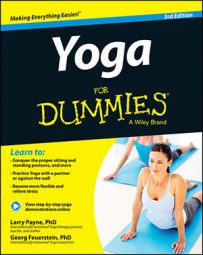Midlife, as the word suggests, refers to the middle of life. With a little extra help from Yoga, it’s not, as some people think, “The End,” but rather a new beginning. Yoga helps you navigate the physical and emotional changes associated with midlife and allows you to age gracefully, healthfully, and actively.
Working through menopause
Menopause signals a major biochemical change in a woman, marked most obviously by the disappearance of her monthly flow. Her body’s sexual glands go into relative retirement, and she can no longer bear children. The hormonal shifts that lead up to actual menopause can take up to a decade.
Perimenopause, the term given to the longer process, can bring with it a host of undesirable side effects: hot flashes, palpitations, dizzy spells, insomnia, vaginal dryness, urinary problems, and irritability. This time of life can make women prone to depression, but with an attitude of acceptance for the change and the possibilities yet to come, it can actually be a satisfying time of life. Yoga comes into play here.
Regular Yoga practice can help alleviate the physiological side effects of menopause, especially if you start a few years before its onset, and help you cultivate a forgiving, accepting, and positive attitude important for your emotional well-being.
Inversions, which have a profound effect on the glands and inner organs and (both literally and figuratively) allow you to view things from a new perspective, are especially helpful. For soothing rest and whole-person recovery, cultivate the corpse posture. Just give your body a chance to rebalance its chemistry.
Not just a “woman thing”: Navigating andropause
Men experience something similar to menopause, called andropause. Although changes in their sexual glands may lessen their sex drives, men can continue to sire children into old age. But when they see their vitality and hairline recede a little, men are often thrown into an existential crisis.
Midlife offers a great opportunity to discover life’s possibilities beyond sexual reproduction and raising children. Regular Yoga practice can buffer the unpleasant physiological side effects of andropause and stabilize the emotions triggered when you realize you’re no longer quite so dashing — unless, of course, you have practiced Yoga all along.
Developing bones of steel
With regular exercise, you can prevent the bone loss (osteoporosis) associated with midlife and old age. Regular weight-bearing exercises strengthen your bones, but stress causes acidity, which leaches the calcium from your bones. Many people don’t realize that osteoporosis actually starts in your mid- to late 20s. Therefore, you can’t begin Yoga too early — and it’s never too late to take it up!

